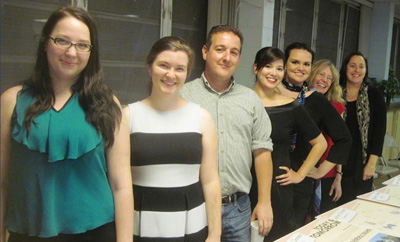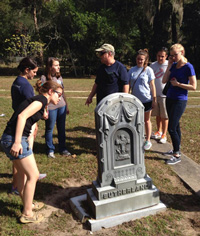University of Florida Historic Preservation Student and Alumni Organization, Gainesville, Florida

Katherine Jacob
Katie Jacob earned her bachelor's in art history from Emory University in 2010. After taking a few years off from school to teach, she chose to get her Masters in Historic Preservation from the University of Florida. She was the US/ICOMOS intern in 2014 where she worked with the International National Trust Organization in London, England. This experience helped spurn her interest in international preservation work and the organizations that surround it. After graduation, she will be going to Preservation Institute Nantucket, and hopes to have a job working to advocate historic preservation as a catalyst for development. She was the leader of the University of Florida Historic Preservation Student and Alumni Organization.
Sheena D. Simmons
Master of Historic Preservation Candidate, University of Florida, member of the Historic Preservation Student and Alumni Organization.
What led you to your major?
Katie: It was very accidental; I came across Historic Preservation while deciding what to go to graduate school in. I completed my undergrad in Art History and just believed that I would continue to Masters and PhD in that. However, I had quite the anxiety attack over having to study one artist for the rest of my career. I looked at similar programs and came across the historic preservation page at the University of Texas, and delved deeper into preservation Web sites. Preservation is so open-ended, there are standards, but you can do anything with the field such as law, archaeology, advocacy, policy-making, and consultation. Plus you get to work with beautiful historical places. When I met with the Director of Historic Preservation at UF, Morris Hylton, I knew that this is what I want a career in.
Sheena: I always loved old buildings, historic cores of cities, historic plazas and parks, and historic cemeteries. Perhaps I can credit my grandfather with instilling this interest in me, as he often took me on trips to visit historic places as a child, and our trips consisted more of strolling through outdoor spaces than examining interiors. My interest in preservation is mainly in the vast area of public spaces and landscapes.
As an undergraduate, I majored in art history and anthropology. Before pursuing a graduate degree in preservation, I worked in the arts, most recently as a public art curator for a large state university in the Tampa Bay area. I was able to find an overlap between public art administration and preservation when I began to read about the concept of cultural landscapes, among other preservation issues. This combined with my desire to leave the arts, but still work in a creative capacity and continue to work in community engagement led me to pursue a graduate degree in historic preservation. Before I decided to apply to graduate school, I attended a few NCPTT workshops, some local preservation board meetings that were open to the public, and began volunteering at preservation organizations a few hours a week. This solidified my decision to transition into historic preservation.
Why was the UF historic preservation student and alumni organization created?
Katie: It was created to bring young preservationists together with more experienced preservationists. It is an open group to share ideas with a small core group of people on campus. Anybody interested in the preservationist field is welcome to join.
What is the relationship between the UF historic preservation students and alumni? How does this relationship benefit the community and the students?
Katie: The relationship is one of learning. Our alumni stay connected with the group through social media. They post new opportunities to our Facebook page. GatorNation is everywhere, and having a large alumni base really helps our graduating students.
How does what you do relate to historic preservation?
Katie: HPSAO works in a learning community about preservation. The students' individual projects help influence our discussions. We try to take trips to historic properties within the Gainesville area such as Dudley Farms, Haile Plantation, and the Marjorie Rawlings house. We also try to do practicum projects to help students such as graphic design, resume building, and craftsmen projects such as masonry cleaning and window demonstration. It is really about taking what the graduate students learn in the classroom and applying it to real life.
Why do you think historic preservation matters?
Katie: Historic preservation matters because it is important for a community to understand and accept its past. It provides the opportunity for communities to manage change while still keeping its sense of place alive. People deal with preservation everyday whether they realize it or not because they live in ever-changing cultural landscapes. It also helps provide a sense of pride to people and where they live. Preservation matters because it is the brick and mortar reminder of what it takes to create not just a town or a building, but a living and breathing community. A building is nothing without the people who embrace it.
Do you have a favorite preservation project? What about it made it special?
Katie: One of my favorite preservation projects takes place at the Preservation Institute: Nantucket, where many HPSAO members participate in each year. While here we have more of a hands-on experience with the building to create a final Historic Structure Report. It was special because we worked in a team with graduate students from different countries, so it was a very international experience. Also the houses there are older than the ones in Florida and really represent the traditional preservation movement. The hands-on materials included paint and mortar analysis which was interesting and different because in the classroom it is more theory-based.
Another fun project was the graduate student HPSAO members worked on the nomination for a local historic district for Bayshore Gardens, Florida. It was one of the first times students were out in the community working with people to show how historically important their houses were. It was special because we were truly interacting with the community in a way that gave them pride in their mid-century houses that was not there before. The students were excited to provide the survey work and research on the houses, and I am happy to say the neighborhood is running with it and continuing the efforts toward nominations.
We also meet with the historic graveyard in Gainesville and do a stone cleaning on Halloween, which I think is incredibly fun and would love to see it become a community event.
Sheena: I will list two recent projects that pulled at my heart strings:
1. 55 Union St, Nantucket, MA
In Nantucket, Pen Austin (a formally trained traditional craftsperson specializing in plaster) just sympathetically restored an early 19th century house from the ground up. The project is utterly captivating because of the severely dilapidated state of the house at the beginning of restoration compared to the pristine condition now. The original lath is still in place, the timber frame was mostly salvaged, the walls were all either repaired (cut and patched) or entirely re-plastered with lime slaked nearby. It is a great example of traditional building crafts being contemporarily relevant. It is also a testament to how resilient traditional materials and structures can be with the right attention.
https://www.nantucketpreservation.org/55-union-street-3722
2. Bro Bowl, Tampa, FLThe "Bro Bowl" was one of the few concrete skateboard bowls from the 1970s remaining in the U.S. It had a legacy and was still used daily by the local community and occasionally by national visitors. Sadly, this site was destroyed in June 2015 despite community disapproval. However, I still name it here as a favorite project because of the populist initiative that got the site listed on the National Register of Historic Places and delayed the destruction process long enough to at least draw attention to it and negotiation mitigation. Young skateboarders, a demographic that is not usually associated with preservation, rallied and sought help from the community and managed to get the site listed in short order. It was an inspirational process to witness in media and in person.
Can you tell us what you are working on right now?
Katie: I recently completed my Masters and have transferred Presidency to a future preservation student. I am working as an Intern with the Office of International Affairs with the National Park Service researching for the new World Heritage Tentative list that will debut in 2016. Also searching for full-time employment in the preservation field.
How do you think the national historic preservation programs help your community?
Katie: National Historic Preservation programs help communities because they provide the guidance needed. They clarify federal policies and exchange best practices between communities. They provide an area of communication and social reach that would not be possible if communities were not connected to a larger voice.
Sheena: I think the National Historic Landmark status of Ybor City helps to anchor some attention on the unique history of Tampa, a place where most energy and focus is still on new development, and where a large population of transient and seasonal residents otherwise might not ever take note of the local heritage.
The ACHP's mission is "preserving America's heritage;" can you give us an example of how your community is preserving its heritage?
Katie: UF is on the brink of new preservation practices. Gainesville is becoming a new center for entrepreneurial growth, and it is important that preservationists and people moving there recognize the importance of managing change properly. UF and HPSAO seek to make people proud of their communities and seek to make it a historical walkable community for incoming residents. There are currently some anti-preservation local lawmakers in power, and HPSAO and the UF community participates in local government to help stop the negative development in the area. UF/HPSAO themes have also been relating to documenting heritage through laser scanning that will be affected by climate change. This is particularly important to Florida as it will soon be one of the most affected areas of sea-level rise.
Sheena: A local non-profit, Tampa Preservation, Inc., both serves as a hub for the local preservation community and disseminates preservation information. They organize workshops that focus on the material of historic homes. For example, they host an annual workshop that focuses on "wood window makeovers" to discourage homeowners from replacing their historic windows. It also has an award and recognition program for homes that have been notably preserved or restored. To draw attention to the property and efforts of the owner, a tasteful cloth banner is awarded to hang outside the home. This program encourages preservation of private residences - bungalows, Craftsman, and other architectural styles in the historic neighborhoods of Tampa, including Seminole Heights, Hyde Park, and Bayshore.
Read more Q&A stories about the preservationists in your neighborhood!